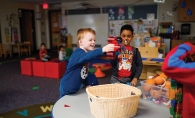For Inspiration and Recognition of Science and Technology, or FIRST—as in the FIRST robotics program—is an annual competition sweeping the nation. But at Edina High School, “first” means even more, as EHS built the first robotics team in Minnesota to be truly sustained over a period of ten years. It was 2005 when Chris Miller, an EHS junior at the time, and a group of 13 fellow students started the team, building their first robot right in Miller’s kitchen.
That first group included team mentor Laurie Shimizu’s son, Evan. “They thought it would be tremendous fun; something hands-on with all of the science and math they were learning,” Shimizu says. “It’s been a whirlwind ever since.”
Known as “The Green Machine,” the EHS robotics team has advanced to the FIRST World Championships in eight of nine completed seasons. Shimizu’s youngest son, Ken, was also a member of the Green Machine from 2011 to 2014. Both Shimizu boys have since gone on to study in STEM fields in college.
Shimizu explains that the whole idea of the FIRST program is “to get people involved, engaged and learn what it means to be in a STEM [science, technology, engineering and math] program.”
The six-week building season begins in January, when a challenge is unveiled for teams all over the globe, from China to France to Israel. Typically, the robot challenge is a game—think shooting basketballs or developing a robotic arm. Students have only a few weeks to design, program and prepare their robot for competition.
“It can be difficult to decide what to focus on in the game; there is usually more than one task,” says Green Machine co-captain Kirsten Sakaguchi. “It’s better to pick the most valuable thing and do it well and consistently.”
Edina’s Green Machine has grown to include dozens of students in grades 10 to 12; this year’s team has 51 members. Sakaguchi, a senior, has been involved with robotics since seventh grade. “I’ve always kind of liked sciences and math… it looked like a lot of fun,” she says.
The robotics team is not funded by Edina Public Schools, though they do provide space. Students also get a bit of a business education by developing a pitch and fundraising.
Eighteen adults (including one faculty member) volunteer as mentors. Many have their own robotics experiences and careers as engineers, computer programmers and other STEM professions. Matt Mittag, an engineer at Dow Water and Process Solutions in Edina, has been a Green Machine mentor for four years. “I know what robotics can do for a young person’s life,” he says. Mittag coaches students, attends competitions and makes sure things are safe and fun.
Mittag and the other mentors do not guide students step-by-step through any part of the process. “The No. 1 goal is to let kids do what they want and experiment… you learn a lot more when you make mistakes,” he says.
It’s not all technical, though. Robotics competitions also include speaking to judges about safe practices, business plans and promoting STEM.
EHS senior Erika Ding is the Green Machine’s outreach captain. “We have to exemplify the values of FIRST,” she says.
One way Green Machine promotes STEM disciplines is by hosting FIRST Day in Edina each January. Students participate in Robot Day at the Minnesota Children’s Museum in St. Paul and The Works Museum in Bloomington. “Seeing kids super-hyped on science is really interesting,” Ding says.
&
For more information visit usfirst.org or edinarobotics.com.









